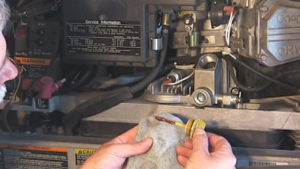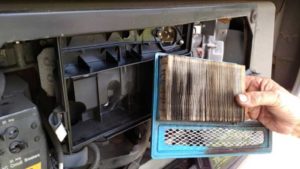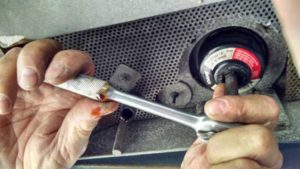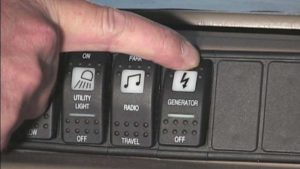rv education 101
Preventive Maintenance of your Gas Generator/span>
I talk about preventive maintenance (PM) all the time because it is effective in heading off more serious and costly maintenance issues caused by mechanical breakdowns, malfunctions or failure of a component or system. Preventive Maintenance consists of cleaning, inspecting, lubricating, adjusting and servicing your RV before there is a problem.
Today I want to discuss 7 PM checks you can perform on a typical RV generator. In addition to these checks you should always follow the maintenance schedule and guidelines that came with your specific generator set.
Note: These PM checks are for a gasoline generator. Diesel motorhomes come equipped with a diesel or propane generator. Some of these checks apply to all generators, but some don’t. Consult your generator owner’s manual for maintenance checks and services for your specific generator.
1) Always check the oil level and the exhaust system prior to starting the generator. Starting and running a generator that is low on oil can result in costly damage to the generator’s engine. Add the proper type oil as required. Check your owner’s manual for the type of oil to use. A damaged exhaust system can result in carbon monoxide gas getting inside the RV. Always inspect the entire generator exhaust system prior to starting the generator. Never operate a generator with a damaged exhaust system!
2) Keep the generator set and the compartment it is housed in clean. You can use compressed air to assist in cleaning the generator compartment, and a clean shop rag to clean the generator set. While you are cleaning the generator check all electrical connectors for secure connections.
Note: always wear safety glasses when using compressed air.
3) Check all of the filters on the generator. A typical generator will have an air filter, fuel filter and oil filter. Check your generator owner’s manual for the types of filters your generator has and where they are located. Maintenance checks and services for a generator are based on hours of operation. You need to monitor the hour meter on your generator set for all maintenance intervals.
a) Check the air filter for cleanliness. You can remove it and inspect the fins on the back of the filter for signs of dirt or debris. You can tap the air filter on a flat surface to help remove some of the dirt and debris. Change a dirty filter, or change it at prescribed intervals. Inspect the air filter more often in dusty operating conditions.
b) The fuel filter will typically be an in-line type filter. Over time it filters out and collects enough debris that it can interfere with the flow of fuel. Check and replace the fuel filter at prescribed intervals.
c) We’ll talk more about the oil filter in just a minute.
4) Change the oil and oil filter (if equipped). This is perhaps the most important PM service you can perform on your generator to ensure years of reliable service. Change the oil and replace the oil filter at the recommended intervals. It’s really quite simple to do. Your generator owner’s manual will usually describe the steps to follow. If you don’t feel comfortable changing the oil and filter have an authorized RV service center do it for you.
5) Replace the spark plugs at recommended intervals. If you have replaced spark plugs in a vehicle you can replace the plugs in a generator, unless due to constraints of the generator compartment you can’t access the spark plugs. In this case you may want to let an authorized RV service center do it for you. If you decide to do it yourself check your generator owner’s manual for the correct type of plug to use, and double check the spark plug gap before installing the plugs. Do not over tighten spark plugs!
6) Exercise the generator. There are several reasons why you should start and exercise the generator on a regular basis. Moisture build-up can cause damage to your generator. When you exercise your generator, it heats the generator windings and eliminates this moisture build-up. This monthly exercise regime also lubricates all of the engine seals and components and helps to prevent carbon build-up. So, what exactly do I mean when I say exercise your generator? For a gasoline generator it means you start and run the generator with at least a 50 % load, for at least two hours every month. It is extremely important that you run it with this minimum rated load. Generators are designed to run with a load. It’s always better to let your generator run for longer periods of time than it is for short periods. Check your generator owner’s manual for load ratings specific to your unit. Always try to avoid starting or stopping a generator when there is a 120-volt device or appliance turned on.
7) Add a fuel stabilizer during periods of storage or non-use. Add a fuel stabilizer to the motorhome or generator’s gas tank and run the generator long enough for the stabilizer to get through the fuel system. This will help prevent gas related problems on carbureted generators, like not starting or surging. These are problems you don’t need. Fuel stabilizers can protect the fuel system for up to six months, but keep in mind the importance of exercising the generator when possible.
Well there you have it. Follow these simple PM steps, and the maintenance and service instructions in the generator owner’s manual, and you can get years of reliable service from your generator set. A couple additional tips for generator maintenance are to keep the starting battery maintained, and when running the generator monitor the AC voltage and frequency output with some type of digital line meter. I recommend one that can test polarity, measure AC line voltage and AC frequency. Frequency is the number of times that electricity alternates per second. U.S. appliances are designed to operate at 60 cycles per second, or 60 hertz. When you use your generator the governor in the generator must hold the speed constant at, or close to 60 hertz from no load on the generator to a full load. Depending on the load placed on the generator, AC voltage can range from 105 to 135 volts and the frequency can range from 58 to 63 hertz. Anything outside of these parameters can cause problems for your RV electrical system and/or generator set. The meter will let you know when the generator is not operating within the proper ranges and you can have it checked out and repaired before any damage occurs.
For more information about RV safety and using your RV visit our RV Online Training Center and check out the RV video training courses and RV e-book training courses we have to offer.
Happy Camping
Mark J. Polk
RV Education 101





